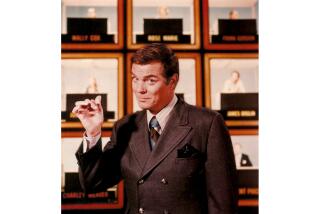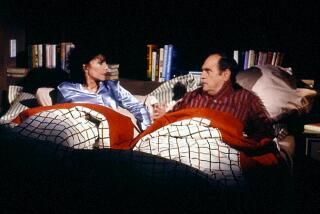Bill Littlejohn dies at 96; animation artist
Bill Littlejohn, an animator whose work ranged from MGM’s “Tom and Jerry” shorts and the independent films of John and Faith Hubley to the popular “Peanuts” specials, died Friday night of natural causes at his home in Malibu. He was 96.
Born in Newark, N.J., in 1914, Littlejohn began his animation career in 1931. “Fear of starving led me to animation — those were Depression days,” he recalled in a 1985 interview. “I had no art training, but learned animation from a do-it-yourself kit. I had an aunt who worked in the camera department of the Van Beuren Studios in New York, where I got my first job.”
Littlejohn began as a cel washer, cleaning the clear sheets of acetate that the characters were inked and painted on so they could be reused in other cartoons. But he quickly moved up the ranks to animator, working on Van Beuren’s now largely forgotten series “Toonerville Trolley,” “Parrotville” and a short-lived cartoon adaptation of the hit radio show “Amos and Andy.”
Although he later dismissed these films as “no damn good,” Littlejohn said he enjoyed animating the parrots slipping and sliding around: “I could whip the characters around in the kind of wild action I loved to do.”
In 1935, Littlejohn left New York and animation to pursue a degree in aeronautical engineering in Los Angeles. But he found his co-workers at Lockheed boring (“they talked about rivets”), and in 1937 joined the animation unit at MGM, where he worked on the “Happy Harmonies” cartoons and the Oscar-winning “Tom and Jerry” series.
During the late ‘30s and early ‘40s, Littlejohn became active in the movement to unionize the animation industry and helped organize the watershed strike at the Walt Disney Studio in 1941.
“Bill Littlejohn was the last of the dynamic Hollywood union organizers of the 1930s and ‘40s,” Tom Sito, president emeritus of the Hollywood Animation Guild Local No.839, said. “His activism did much to build the standard of living studio animators have today.”
During World War II, Littlejohn did freelance animation for the MGM and Walter Lantz studios while serving in the Army as a test pilot. After the war, he did his most famous animation for independent filmmakers and television studios and worked on numerous commercials for Playhouse Pictures, Jay Ward Productions, Fine Arts Films and others. His acclaimed animation of a character that was part car and part cat for the Uni-Royal “Tiger Paws” spots remains popular on YouTube decades later.
Littlejohn was a principal animator on the many “Peanuts” specials and features by Bill Melendez Productions. He drew Snoopy’s most outrageous antics and said he particularly enjoyed a sequence in “Snoopy, Come Home” (1972) in which a frenetic little girl ties up the hapless beagle, changes his name to “Rex” and gives him a bath.
Some of Littlejohn’s best-known work was done for the husband-and-wife team of John and Faith Hubley. He did the principal animation for their Oscar-winning short “The Hole” (1962), in which two New York street workers debate the possibilities of nuclear war. He contributed to “The Hat,” “Of Stars and Men,” “Enter Life” and many other films, and animated Zonker Harris placing daisies in the muzzles of National Guardsmen’s rifles in the Oscar-nominated “A Doonesbury Special” (1977), John Hubley’s last film.
Throughout his long career, Littlejohn remained a passionate advocate of animation as an art form. In the mid-’60s, he was one of the founders of the International Tournées of Animation, a program of shorts from around the world that played at museums throughout the United States and helped organize the Olympiad of Animation for the 1984 Olympic Arts Festival. Littlejohn co-founded ASIFA/Hollywood, the local chapter of the international animation society, and received its “Annie” award for career achievement in 1981. He served as president of the Screen Cartoonists Guild and represented the short films branch on the Board of Governors of the Motion Picture Academy from 1988 to 2001.
Littlejohn’s wife of 61 years, artist and actress Fini Rudiger Littlejohn, died in 2004. He is survived by a son and a daughter, Steve Littlejohn and Toni Littlejohn, and three grandchildren.
news.obits@latimes.com
More to Read
Start your day right
Sign up for Essential California for the L.A. Times biggest news, features and recommendations in your inbox six days a week.
You may occasionally receive promotional content from the Los Angeles Times.






